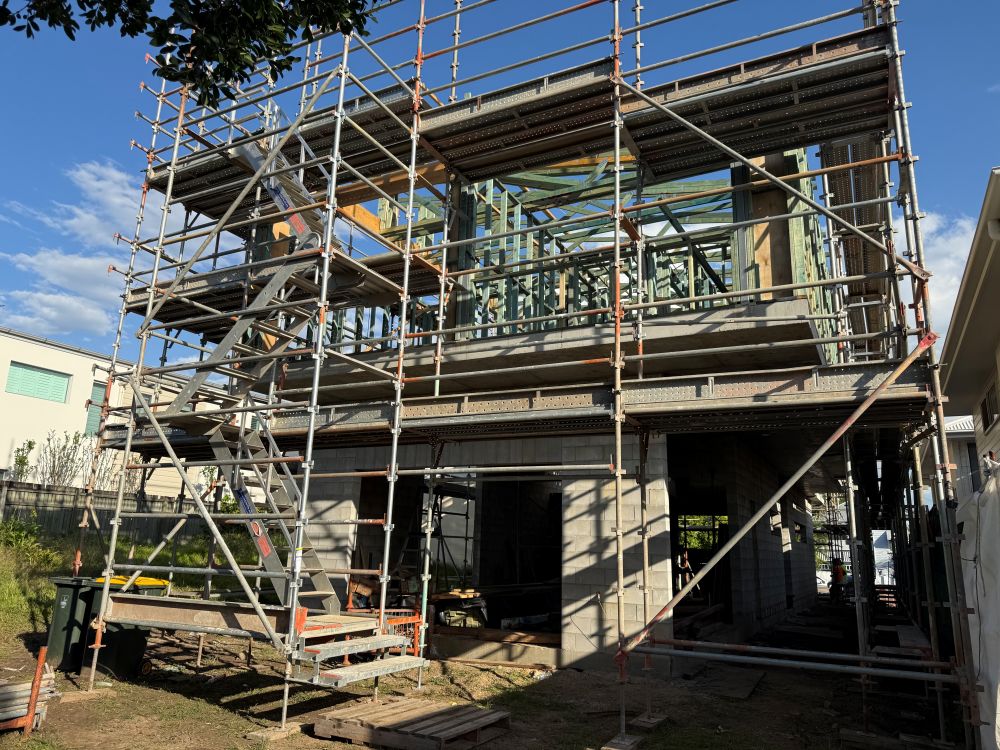Enhancing Safety and Compliance by Understanding Scaffold Load Capacity in Construction
Scaffold load capacity is a pivotal aspect of construction that indicates the maximum weight a scaffold can safely support while in use. This critical factor encompasses three primary categories of loads that require meticulous evaluation:
- The weight of the scaffold itself, commonly referred to as the dead load, which includes the materials and components that constitute the scaffold structure.
- The weight of workers, tools, and materials that are placed on the scaffold (known as the live load), which can fluctuate based on the number of personnel and equipment involved.
- External forces such as wind, rain, or vibrations that can impact the scaffold's integrity (classified as environmental load), necessitating special attention to weather conditions and site location.
Grasping these load categories is vital, as they directly affect the overall stress exerted on a scaffold during its operation. Adhering to these calculations is not merely a recommendation; it is mandated by Australian law to safeguard the well-being of all individuals engaged in construction activities.

Utilizing Our Scaffold Load and Height Calculator: A Comprehensive Step-by-Step Approach
Although a universal formula for all scaffold configurations does not exist, our scaffold calculator offers a straightforward method for obtaining precise estimates by simplifying essential variables. This tool is specifically designed for residential builders, homeowners, and scaffold hire professionals who are required to adhere to the guidelines established by Australian OHS standards.
Step 1: Identify the Type of Work
Begin by determining the specific nature of the work involved, which may encompass tasks such as roof restoration, exterior painting, solar panel installation, cladding, or rendering, each requiring a unique scaffold setup.
Step 2: Specify the Number of Workers Involved
For instance, you might indicate that two workers will be collaborating on the scaffold platform simultaneously to ensure accurate load calculations and safety measures.
Step 3: Estimate the Weight of Materials
This could encompass around 120 kg worth of rendering materials or tools that will be utilized during the project, which is critical for determining the overall load capacity required.
Step 4: Input the Height of the Scaffold Platform
For example, you could specify that the height is set at 4.5 metres above ground level, which plays a significant role in the scaffold's stability and safety requirements.
After entering this information, the calculator will provide a recommended scaffold configuration that includes:
- The appropriate duty class (such as Light, Medium, or Heavy), tailored to the specific project needs.
- An estimation of the Safe Working Load (SWL) per bay, ensuring safe usage of the scaffold.
- The recommended scaffold type (such as aluminium tower or steel frame), based on the project requirements.
- Essential safety features required (including guardrails, soleplates, and stabilisers) to enhance worker safety.
- Any compliance triggers related to height (such as tie-offs that are necessary for structures exceeding 4 metres).
Understanding the Lack of a Universal Load Formula for Scaffolding
While the scaffold calculator serves as a practical tool for generating estimates, it is essential to note that scaffolders and engineers do not depend solely on a single formula. There are several compelling reasons for this approach:
- Scaffold systems can differ significantly based on their materials and designs (including aluminium, steel, modular, and tube-and-coupler systems), each with unique load capacities.
- The intended purpose greatly impacts the load capacity (for example, painting requires different considerations compared to masonry work).
- Various manufacturers offer differing platform strength and component ratings, which can lead to inconsistencies in load calculations.
Industry Standards for Calculating Safe Working Load (SWL)
Professionals in the field often reference the following formula as a cornerstone for making estimations:
Safe Working Load (SWL) per bay = (Platform Load Rating × Safety Factor) – Scaffold Component Weight
Illustrative Example:
- A platform rated for a maximum load of 600 kg provides a baseline for calculations.
- Applying a 4:1 safety margin: only utilizing 25% of the rating yields 150 kg that can safely be supported.
- Subtracting the weight of the scaffold structure, which may weigh 100 kg, is critical for accurate calculations.
- The resulting usable working load is 50 kg, which serves as a conservative estimate and is typically not indicative of actual planning.
Given the complexities of real-world conditions, professional scaffolders typically adhere to manufacturer guidelines, engineering tables, and local regulations instead of relying exclusively on this simplified formula.

Implementing Best Practices for Scaffold Evaluations by Professionals
Professional scaffold evaluations generally encompass the following essential components to ensure safety and compliance:
- Reviewing manufacturer load data and confirmed span ratings for accuracy and reliability.
- Calculating the total live, dead, and environmental loads to verify safety and structural integrity.
- Ensuring adherence to AS/NZS duty class specifications to align with industry standards.
- Obtaining engineering sign-off for any tailored or elevated scaffold configurations, which is crucial for safety assurance.
- Conducting comprehensive visual and structural inspections prior to scaffold use to identify and rectify any potential hazards.
Customizing Scaffold Practices to Suit Environmental Conditions and Site-Specific Factors
Addressing Wind Exposure in Coastal Queensland
In areas classified under wind zones N3 and N4, the lateral forces exerted on scaffolds are considerably increased. Consequently, scaffolds must be anchored at shorter intervals, and additional bracing or shade cloth may be necessary, particularly during periods of high wind, to maintain structural stability.
Considerations for Soil and Ground Types
When encountering unstable or sloped soil conditions, it is imperative to utilize soleplates and adjustable base jacks to enhance scaffold stability. Additionally, sites with varying elevations may require the implementation of leveled bay systems to ensure a safe working environment for all personnel.
Regulations for Platforms Exceeding Four Metres
In Queensland, any platform exceeding four metres in height mandates thorough inspection and certification. A scaffold handover certificate is essential under the Work Health and Safety Regulation 2011, ensuring compliance with established safety standards and protocols.
Key Safety Regulations to Follow for Scaffold Use
- Work Health and Safety Regulation 2011 (QLD), which outlines critical safety measures.
- Managing the Risk of Falls at Workplaces (Code of Practice, 2021), providing guidelines to mitigate fall risks.
- AS/NZS 1576 and AS/NZS 4576 Standards that govern scaffold safety protocols and practices.
- High Risk Work Licence (HRWL) is required for any scaffold installation above four metres, ensuring qualified personnel manage the setup.
Site supervisors hold the responsibility for conducting routine inspections, particularly following adverse weather events or significant alterations to scaffold height or load, thereby ensuring ongoing compliance with safety regulations and standards.
Real-World Case Study: Scaffold Implementation in Robina
In a recent project situated in Gold Coast, a homeowner in Robina required scaffolding services to repaint and render a two-storey exterior wall. The working height for this undertaking was established at five metres, with two tradespeople using approximately 200 kg of rendering materials and tools throughout the process.
Utilizing our scaffold calculator, the proposed configuration was as follows:
- Scaffold class: Medium Duty, appropriate for the tasks at hand.
- System type: Steel frame equipped with timber planks for enhanced durability and safety.
- Additional safety measures: Full edge protection, soleplates for soft earth conditions, and wind mesh to mitigate wind exposure.
The scaffold successfully passed all mandated inspections and complied with Queensland’s OHS regulations, resulting in zero downtime during the project's execution.
Critical Factors in Scaffold Height and Load Capacity Calculations
Calculating scaffold height and load capacity should never be approached as a matter of guesswork. In residential projects, this detailed process is crucial for ensuring safety, controlling costs effectively, and achieving compliance with local regulations.
Given the specific requirements applicable to Australian conditions, particularly in southeast Queensland, we highly recommend obtaining an accurate scaffolding quote and ensuring that all installations are performed by qualified professionals.
Reach Out to CanDo Scaffolding Hire for Professional Guidance and Services
For further information about our extensive range of services, please do not hesitate to contact us at 1300 226 336 or email us at theguys@cando.com.au at your convenience.
We provide a comprehensive selection of scaffolding solutions, including void protection platforms and roof edge protection, customized to meet the unique needs of any residential or light commercial construction project.
Understanding Scaffold Load Capacity for Residential Projects
The Article: Scaffold Load Capacity Insights for Residential Projects first appeared on https://writebuff.com
The Article Scaffold Load Capacity for Residential Construction Projects Was Found On https://limitsofstrategy.com

